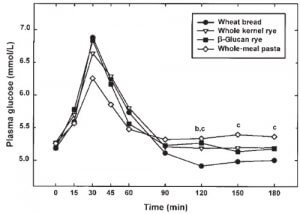Effects of Fiber in Athletes

Found in grains and vegetables, dietary fiber is the edible, but non-digestible part of plant foods. Moreover, because your body can’t absorb or digest dietary fiber, it passes intact through the body. It is partially or completely fermented in the large intestine, by the gut microbiota.
How well fiber ferments depends on the type of fiber and how it retains water. There are two types of fiber and these are: insoluble and soluble.
Insoluble fiber is fermented easily. Containing cellulose and hemicellulose, its main function is to increase the volume in stools. It also helps with intestinal transit.
Pectins and mucilages are a part of the soluble fiber group. They have the ability to capture water and form a gel type substance at the intestinal level. Soluble fibers are fermented in their entirety by the intestinal microbiota.
Functions of dietary fiber
We can group the functions of soluble and insoluble fiber together. Although they are both different, both types are usually present in the food we consume. Dietary fiber has the following benefits:
- It helps to reduce the levels of total cholesterol and LDL.
- It helps with the development of the bacterial flora, which increases the defenses.
- Decreases the impact of blood glucose.
- Protective effect against heart disease.
- It hinders the digestion and absorption of fats.
- Increases the feeling of fullness.
- Prebiotic effect.
- Its fermentation by the intestinal flora results in the production of vitamins (B12) and minerals (Mg) that we absorb.
- It helps to prevent colon cancer and digestive diseases.
Benefits and consequences of fiber consumption
The consumption of fiber by athletes and the general population, brings specific benefits. Its satisfying function can help athletes to reduce or maintain their weight.

Its ability to form a gel like substance limits the absorption of nutrients, in turn, this helps to regulate body weight. In addition, the absorption of carbohydrates is slow and this allows the release of energy over long periods of time.

Consuming fiber also prevents any alterations during intestinal transit. This is a factor that may not seem very specific for athletes. However, a competition will involve travel, changes in schedule, and nervousness etc. So their consumption can help to manage any gastrointestinal disorders.
The nutritional recommendations to experience the beneficial effects are: 0.88-1.24 oz/day. If we reach or exceed 1.76 ounces daily, we increase the risks of suffering with gastrointestinal manifestations such as abdominal distention, bloating, flatulence, and abdominal pain.
“I have failed again and again, that is why I have been successful”
-Michael Jordan-
What conclusions can we draw?
For our daily life, and particularly when we do sport, it’s important that we consume fiber regularly. Although we must give extra consideration to fiber when we are competing or training.
The sensation of swelling and of being full can condition the concentration and comfort of the athlete. Stomach pain creates fatigue and with this, comes a lack of motivation. An athlete who loses motivation will struggle to perform well.
The key lies in consuming a balance of both soluble and insoluble dietary fiber. Quick digestion is always preferable, except when it happens during a sporting event. I think you will understand what we mean by this!
There is no ideal amount or quantity to consume. But the effects of fiber have to be measured and considered by the each athlete. Each individual is different, and sufficient fiber has to be consumed over time in order to avoid surprises.
Found in grains and vegetables, dietary fiber is the edible, but non-digestible part of plant foods. Moreover, because your body can’t absorb or digest dietary fiber, it passes intact through the body. It is partially or completely fermented in the large intestine, by the gut microbiota.
How well fiber ferments depends on the type of fiber and how it retains water. There are two types of fiber and these are: insoluble and soluble.
Insoluble fiber is fermented easily. Containing cellulose and hemicellulose, its main function is to increase the volume in stools. It also helps with intestinal transit.
Pectins and mucilages are a part of the soluble fiber group. They have the ability to capture water and form a gel type substance at the intestinal level. Soluble fibers are fermented in their entirety by the intestinal microbiota.
Functions of dietary fiber
We can group the functions of soluble and insoluble fiber together. Although they are both different, both types are usually present in the food we consume. Dietary fiber has the following benefits:
- It helps to reduce the levels of total cholesterol and LDL.
- It helps with the development of the bacterial flora, which increases the defenses.
- Decreases the impact of blood glucose.
- Protective effect against heart disease.
- It hinders the digestion and absorption of fats.
- Increases the feeling of fullness.
- Prebiotic effect.
- Its fermentation by the intestinal flora results in the production of vitamins (B12) and minerals (Mg) that we absorb.
- It helps to prevent colon cancer and digestive diseases.
Benefits and consequences of fiber consumption
The consumption of fiber by athletes and the general population, brings specific benefits. Its satisfying function can help athletes to reduce or maintain their weight.

Its ability to form a gel like substance limits the absorption of nutrients, in turn, this helps to regulate body weight. In addition, the absorption of carbohydrates is slow and this allows the release of energy over long periods of time.

Consuming fiber also prevents any alterations during intestinal transit. This is a factor that may not seem very specific for athletes. However, a competition will involve travel, changes in schedule, and nervousness etc. So their consumption can help to manage any gastrointestinal disorders.
The nutritional recommendations to experience the beneficial effects are: 0.88-1.24 oz/day. If we reach or exceed 1.76 ounces daily, we increase the risks of suffering with gastrointestinal manifestations such as abdominal distention, bloating, flatulence, and abdominal pain.
“I have failed again and again, that is why I have been successful”
-Michael Jordan-
What conclusions can we draw?
For our daily life, and particularly when we do sport, it’s important that we consume fiber regularly. Although we must give extra consideration to fiber when we are competing or training.
The sensation of swelling and of being full can condition the concentration and comfort of the athlete. Stomach pain creates fatigue and with this, comes a lack of motivation. An athlete who loses motivation will struggle to perform well.
The key lies in consuming a balance of both soluble and insoluble dietary fiber. Quick digestion is always preferable, except when it happens during a sporting event. I think you will understand what we mean by this!
There is no ideal amount or quantity to consume. But the effects of fiber have to be measured and considered by the each athlete. Each individual is different, and sufficient fiber has to be consumed over time in order to avoid surprises.
All cited sources were thoroughly reviewed by our team to ensure their quality, reliability, currency, and validity. The bibliography of this article was considered reliable and of academic or scientific accuracy.
- Gil, M. A. (2005). MANUAL DE NUTRICIÓN DEPORTIVA (Color). Editorial Paidotribo.
- Vilcanqui-Pérez, Fulgencio, & Vílchez-Perales, Carlos. (2017). Fibra dietaria: nuevas definiciones, propiedades funcionales y beneficios para la salud. Revisión. Archivos Latinoamericanos de Nutrición, 67(2), 146-156. Recuperado en 29 de diciembre de 2022, de http://ve.scielo.org/scielo.php?script=sci_arttext&pid=S0004-06222017000200010&lng=es&tlng=es.
This text is provided for informational purposes only and does not replace consultation with a professional. If in doubt, consult your specialist.








